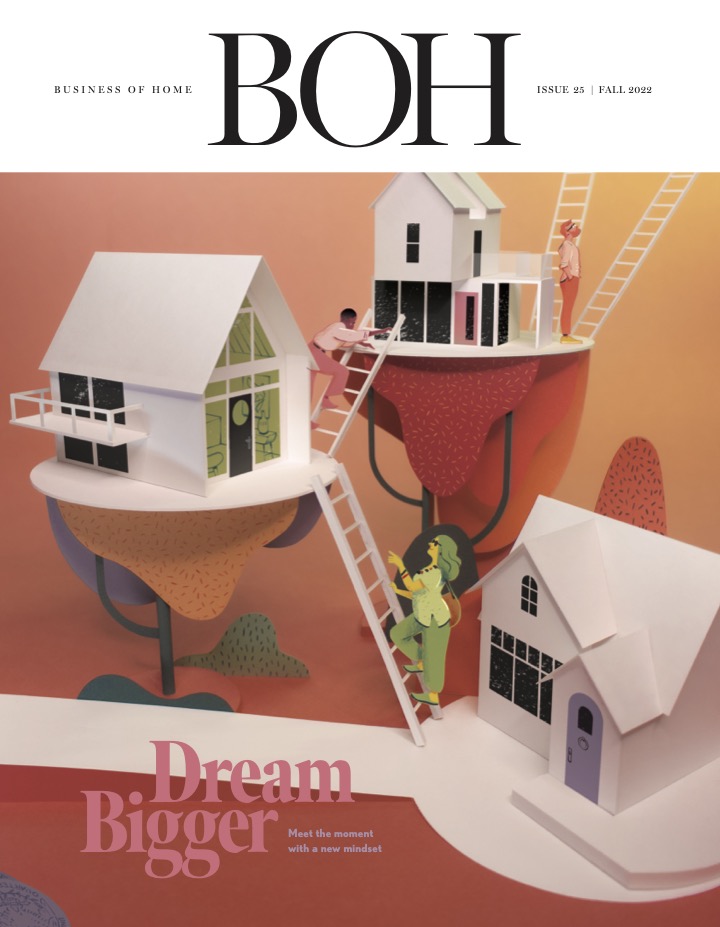It’s official: The “home boom” is over. Though it happened in different corners of the industry at different times, the tapering-off of the pandemic-inspired design world bonanza is certainly the biggest news of the year. But it wasn’t the only news of the year. From e-design collapses to gargantuan fundraises, we take a look back at the major headlines that crossed the BOH news desk in 2022.
Fabricut logs off
At the beginning of the year, Tulsa, Oklahoma–based fabric giant Fabricut announced that it would be pulling its stock from online retailers like Perigold, DecoratorsBest and L.A. Design Concepts. The move was not a huge financial risk for Fabricut—only a tiny percentage of its sales happened online—but it did set the brand apart from other large-scale fabric purveyors, most of whom move yardage online in one form or another. The bet, CEO David Finer told BOH, was that lost revenue would be repaid in designer loyalty: “At the end of the day, the trade has overhead, and they’re going to spend time and money trying to do the best job for a client using that overhead. They deserve to make some margin for their services, and that’s what we’re trying to assist in.”
Scandal arises in Dallas
The CEH was a Texas-based furniture brand beloved by designers for its colorful take on traditional. Then they stopped delivering pieces. In the spring, designers took to Instagram to bemoan missing orders, and the scope of the situation soon became clear: Founders Justin and Diana Evans had taken deposits from dozens of designers and offered up a series of excuses as to why they couldn’t deliver, ranging from COVID-19 to supply chain issues to a dramatic story involving a personal data hack. The Evanses shuttered their website, but a clear explanation for what had happened behind the scenes never emerged.
Retailers feel the pain early
For interior designers, the demand for home services has carried on well into the colder months of 2022. For retailers, it ended abruptly with spring flowers. In May, BOH columnist Warren Shoulberg noted that everyone from Target and Lowe’s to RH and Arhaus had begun to see their sales numbers decline sharply. The exact timing was due to a combination of factors, from the destabilizing Russian invasion of Ukraine to rising inflation and the return to spending on travel, restaurants and entertainment. Whatever the cause, the outlook couldn’t have been clearer: “A home furnishings industry that just a few months ago was scrambling to meet demand now finds itself 180 degrees in the opposite direction,” he wrote.
Material Bank grows a horn
In 2021, the Adam Sandow–founded sampling platform Material Bank announced a staggering fundraise of $100 million. In May of 2022, it shocked the design world once again, hauling in another $175 million in a round led by Canadian investment firm Brookfield. The money, Sandow told BOH, was for hiring “a few hundred” more employees, buffing up its technology, making further acquisitions (a month later, it bought Architizer), moving into the residential side of the industry and banking cash for a predicted economic downturn. The round pegged Material Bank’s value at $1.9 billion, making it the rare design industry “unicorn” startup.
On July 30, designer Sara Malek Barney equips designers with the critical skills to streamline their sourcing process as a means to enhancing profitability without sacrificing integrity—it even includes a discussion on the oft-overlooked topic of markups. Click here to learn more and remember, workshops are free for BOH Insiders.
E-design stumbles
The trials, tribulations and dramatic flameouts of e-design startups have been well-documented over the past five years, but Modsy always seemed like the kind of well-funded, even-keeled operation that could last. Then it abruptly laid off its staff and halted operations this summer, citing an acquisition deal that fell apart at the 11th hour. Only a few months later, the Bed Bath & Beyond–owned platform Decorist closed its doors as well, prompting many in the industry to wonder: Is e-design over?
Interior Define goes MIA
Late last year, Chicago-based DTC brand Interior Define announced an ambitious plan: It intended to open 30 new retail locations by the end of 2022. As we close in on December 31, the company has fallen far short of that goal, and many of its storefronts have eviction notices posted in the window. The year has been a hard one for Interior Define, as it faced a wave of online complaints from consumers whose orders have gone missing throughout the summer, fall and winter. According to BOH’s reporting, the company hit a cash crunch and was unable to pay its vendors and shipping partners—it has also gone through several rounds of layoffs, drastically cutting back on staff.
RH makes trade waves
The brand formerly known as Restoration Hardware has long had a complicated relationship with the to-the-trade portion of the design industry. This winter, it only got more complicated as the Corte Madera, California–based retailer announced the hiring of former Architectural Digest editor Margaret Russell to run a branded publication and the acquisitions of high-end upholstery maker Dmitriy and custom furniture workroom Joseph Jeup. The founders of Dmitriy and Jeup, said RH chairman and CEO Gary Friedman, would be tasked with launching two new divisions: RH Couture Upholstery and RH Bespoke Furniture. Though RH has partnered with trade makers and brands for years, the latest development caused some concern among industry watchers that the pace of acceleration was quickening. “I think they’re planning to build a machine that is a steamroller to the trade industry,” said Dennis Scully, host of The Business of Home Podcast, on a recent episode recapping the year’s industry highs and lows.
What industry events stood out to you this year, and what do you predict we’ll see in the year to come? BOH’s editors would love to hear from you—drop us a line here.
Homepage image: ©Piman Khrutmuang/Adobe Stock





























